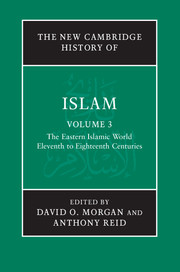Book contents
- Frontmatter
- Introduction: Islam in a plural Asia
- PART I THE IMPACT OF THE STEPPE PEOPLES
- PART II THE GUNPOWDER EMPIRES
- 6 Iran under Safavid rule
- 7 Islamic culture and the Chinggisid restoration: Central Asia in the sixteenth and seventeenth centuries
- 8 India under Mughal rule
- PART III THE MARITIME OECUMENE
- PART IV THEMES
- Glossary
- Bibliography
- Index
- References
8 - India under Mughal rule
from PART II - THE GUNPOWDER EMPIRES
Published online by Cambridge University Press: 28 March 2011
- Frontmatter
- Introduction: Islam in a plural Asia
- PART I THE IMPACT OF THE STEPPE PEOPLES
- PART II THE GUNPOWDER EMPIRES
- 6 Iran under Safavid rule
- 7 Islamic culture and the Chinggisid restoration: Central Asia in the sixteenth and seventeenth centuries
- 8 India under Mughal rule
- PART III THE MARITIME OECUMENE
- PART IV THEMES
- Glossary
- Bibliography
- Index
- References
Summary
Introduction
In 1526 Ẓahīr al-Dīn Muḥammad Bābur (888–937/1483–1530) successfully invaded north India and founded the Mughal empire (932–c. 1152/1526–c. 1739) (see Map 6). Bābur, as he is generally known from his personal name – meaning leopard or tiger – was a Turco-Mongol, Ḥanaf ī Sunnī Muslim native of western Central Asia. He was descended from two Central Asian conquerors. These were the Barlas Turk Temür (736–807/1336–1405), known in Persian as Tīmr-i leng, ‘Tmr the lame’, or in European parlance Tamerlane, and Chinggis Qan (c. 563–625/c. 1167–1227), or in Persian spelling Chingiz Khan. As a patrilineal descendant of Temür he thought of himself in ethnic, social and dynastic terms as a Turk and a Timurid, but he also revered his matrilineal Mongol connections traced through Chinggis Khan’s second son Chaghadai. Raised as an observant Sunn Muslim in the lush Farghāna valley east-south-east of Tashkent, Bābur was also born into the Naqshbandī Sufi order, a doctrinally conservative but politically active devotional order long connected with Temür’s descendants. Bābur both wrote and spoke Turkī, the language common to most contemporary Turks and Mongols, but like many other well-educated men of the region he also knew Persian, the lingua franca and dominant literary language of the Iranian plateau and the cities of Central Asia and north India in the early modern era.
- Type
- Chapter
- Information
- The New Cambridge History of Islam , pp. 266 - 314Publisher: Cambridge University PressPrint publication year: 2010
References
- 1
- Cited by



